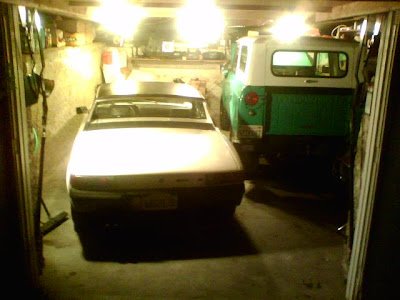1. Lack of motor noise
The gas car is too loud, e.g., descending page mill road in 2nd gear. I want volume control.
2. Lack of manual engine braking
In the white car (1.8L fuel-injected 5 speed), 3rd gear is good from about 25 to 50 mph. The top half of the range (4000-6000 RPM) gives hard acceleration and hard engine braking. The bottom half of the range accelerates/brakes slowly. If you're driving around curves with 30 mph signs, 3rd gear is very responsive. If you're driving around curves with 20 mph signs, you want 2nd gear, and so on. Engine braking is more extreme (and louder) in lower gears.
I read the "Interface Document" for my AC-150 Gen 1 electric system. Above 2000 RPM (around 20 mph in 3rd gear), pedal depression below 30% initiates regenerative braking, with stronger braking as pedal depression drops to 0%. A slider on the instrument panel determines the slope of the pedal-response from 0-30%. The slider replaces your transmission for manual engine braking.
Unfamiliar braking is not only un-fun, it's dangerous. Regenerative braking easily surprises new drivers and can cause loss of traction in slippery conditions.
3 Traction control (not a problem)
The AC-150 also includes inputs for traction control. A wheel-speed sensor is installed on each of the non-drive wheels (i.e., the front wheels of a rear-wheel drive car), which supplies rotation speed information to the power electronics unit (PEU). When the speed of the drive wheels is under/over a threshold, determined by the average non-drive wheel speed, the motor enters traction control by attempting to match the RPM of the drive wheels with the non-drive wheels.
4 Transmissions (interlude)
The gear shifter is still connected to the transmission, but the (electric) car has no clutch. The motor is coupled directly to the transmission through an insulating material (b/c the motor shaft, which is made of copper, cannot contact the transmission, which is grounded to the chassis).
The Porsche 914 has a synchronized manual transmission. When you depress the clutch of a manual transmission and shift into neutral, the transmission input (motor) and output (drive) shafts are decoupled. The wheels continue spinning the drive shaft, and with the clutch depressed, the transmission input shaft spins freely. The brass synchronizer gears help engage new gearing as the two shafts spin at different speeds (read more).
5 Ideas for voiding warranty (override traction control)
Without a clutch, shifting into neutral appears the same a loss of traction to the PEU, which will attempt to spin the motor the same speed as the wheels are spinning in the gear it was calibrated for.
With the shifter in neutral, adjust motor speed for the next gear by overriding the traction control inputs?
Thursday, October 18, 2007
Friday, October 12, 2007
Step 6: Repeat, Start over
My new AC Propulsion AC-150 motor did not arrive directly from AC Propulsion, Inc. of San Dimas, California, makers of advanced electric automotive drive systems, it was delivered in a parking lot in Mountain View, California, mounted inside a bright yellow Porsche 914.
So the white 1974 Porsche 914 with 4-cylinder 1.8L fuel injected engine bought with the intention of converting to electric was saved once again. The yellow car's AC-150 motor delivers twice the power, the white car has Monza exhaust pipes.
The white car needed brake work and a tune-up. The yellow car has the AC-150 mounted and mated to the transmission. I have a first-generation AC-150 controller, a small box of parts, and an instruction manual. It needs an electrical system, a vehicle-control computer, and at least 28 battery cells (338 volts).
The white car stays AWESOME for getting to work: the direct route (33.2 mi – about 37 mins), through Saratoga via Skyline Drive (81.8 mi – about 1 hour 54 mins), or through San Carlos via PCH (52.2 mi – about 1 hour 17 mins).
I passed through San Carlos for a stop at the House of Wreckers, purveyors of tow trucks and towing accessories, to purchase a set of car dollies. I remarked that I had never seen so many tow trucks. The guys in their shop had never seen a Porsche 914 carting off with four GoJak 6200 car dollies on the way to work (at forty pounds each, these fit two in the trunk, two in the passenger seat).
The car dollies let me put two cars in a one-car garage. The yellow car is still in Mountain View.

So the white 1974 Porsche 914 with 4-cylinder 1.8L fuel injected engine bought with the intention of converting to electric was saved once again. The yellow car's AC-150 motor delivers twice the power, the white car has Monza exhaust pipes.
The white car needed brake work and a tune-up. The yellow car has the AC-150 mounted and mated to the transmission. I have a first-generation AC-150 controller, a small box of parts, and an instruction manual. It needs an electrical system, a vehicle-control computer, and at least 28 battery cells (338 volts).
The white car stays AWESOME for getting to work: the direct route (33.2 mi – about 37 mins), through Saratoga via Skyline Drive (81.8 mi – about 1 hour 54 mins), or through San Carlos via PCH (52.2 mi – about 1 hour 17 mins).
I passed through San Carlos for a stop at the House of Wreckers, purveyors of tow trucks and towing accessories, to purchase a set of car dollies. I remarked that I had never seen so many tow trucks. The guys in their shop had never seen a Porsche 914 carting off with four GoJak 6200 car dollies on the way to work (at forty pounds each, these fit two in the trunk, two in the passenger seat).
The car dollies let me put two cars in a one-car garage. The yellow car is still in Mountain View.
Subscribe to:
Posts (Atom)